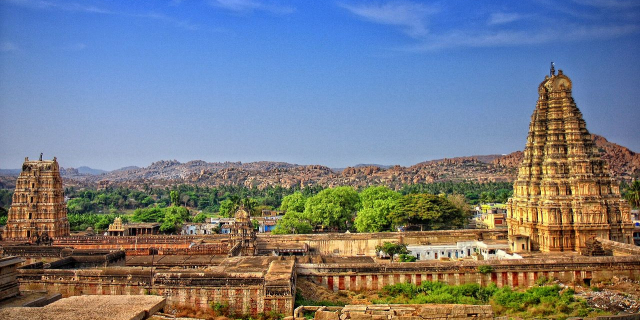चित्रदुर्ग
( Chitradurga )
Chitradurga is a city and the headquarters of Chitradurga district, which is located on the valley of the Vedavati river in the central part of the Indian state of Karnataka. Chitradurga is a place with historical significance which is located to the North West about 200 km from the state capital Bengaluru. Chitradurga is a major tourist hub in Karnataka.
The city is famous for its 15th-century fort, which is locally known as Kallina Kote or Stone Fortress. This is formed of two Kannada words: ‘Kallina’ means "Stone's" and Kote means "Fort". Other names used in Kannada are ‘Ukkina Kote": "Steel Fort" (metaphorically used to mean an impregnable fort) and ‘Yelusuttina Kote’: "Seven Circles Fort".
Chitradurga features bold rock hills and picturesque valleys, with huge towering boulders in numerous shapes. It is known as the "stone fortress" (Kallina Kote). According to the epic Mahabharatha, a man-eating Rakshasa named Hidimba and his sister Hidimbi lived on the hill. Hidimba was a source of terror to everyone around, while Hidimbi was a peace-loving rakshasi. When the Pandavas came with their mother Kunti in the course of their exile, Bhima had a duel with Hidimba in which Hidimba was killed. Bhima married Hidimbi and they had a son named Ghatotkacha, who had magical powers. Legend has it the boulders were part of the arsenal used by Bhima during that duel. The boulders on which a major part of the city was developed belong to the oldest rock formation in the country.
Timmana Nayaka, a chieftain under the Vijayanagar Empire, was appointed as governor of Chitradurga as a reward from the Vijayanagara ruler for his excellence in military services. This was the beginning of the rule of the Nayakas of Chitradurga. His son Obana Nayaka is known by the name Madakari Nayaka (1588 CE). (He was the last ruler of Chitradurga. His name comes from his ability to have suppressed the arrogance- "Mada" of a particular troublesome elephant- "Kari"). Madakari Nayaka's son Kasturi Rangappa (1602) succeeded him and consolidated the kingdom to rule peacefully. As he had no heirs to succeed him, his adopted son, the apparent heir, was enthroned. But he was killed a few months later by the Dalavayis.
Chikkanna Nayaka (1676), the brother of Madakari Nayaka II, served on the throne. His brother succeeded him in 1686 with the title Madakari Nayaka III. The Dalawayis overthrow of Madakari Nayaka III's rule gave an opportunity to one of their distant relatives, Bharamappa Nayaka, to ascend the throne in 1689. He is known as the greatest of the Nayaka rulers. The subjects of Chitradurga suffered through the brief reigns of the successive rulers, which resulted in volatile conditions. The Hiri Madakari Nayaka IV (1721), Kasturi Rangappa Nayaka II (1748), Madakari Nayaka V (1758) ruled this area, but there is not much documentation of their rule.[1]
Legend of Onake Obavva An opening in the rocks of Chitradurga fort that was used by Hyder Ali for an attempted invasion by his soldiers. This was defeated by Obavva.
An opening in the rocks of Chitradurga fort that was used by Hyder Ali for an attempted invasion by his soldiers. This was defeated by Obavva.During the reign of Madakari Nayaka, the town of Chitradurga was besieged by troops of Hyder Ali. A chance sighting of a woman entering the Chitradurga fort through an opening in the rocks led to a clever plan by Hyder Ali to send his soldiers through the hole. The guard on duty near that hole had gone home for lunch. Obavva, the wife of that guard, was passing by the hole to collect water, when she noticed soldiers emerging into the fort. Obavva was carrying an Onake (a long wooden club meant for pounding paddy grains).
She killed Hyder Ali's soldiers one by one as they attempted to enter the fort through the opening and moved the dead. Over a short period of time, hundreds of soldiers entered and fell, without raising any suspicion. After returning from lunch, Obavva's husband was shocked to see Obavva standing with a blood-stained Onake and hundreds of dead enemy bodies around her. Together both wife and husband beat up most of the soldiers. But as both were about to finish off the soldiers, Obavva died.
The opening in the rocks remains as a historical marker for this account. The Tanniru doni, the well that Obavva was going to when she saw the invading soldiers, has also survived. Though Obavva saved the fort on that occasion, Madakari Nayaka could not repel another attack in 1779 by Hyder Ali. In the ensuing battle, the fort of Chitradurga fell to the invader. Obavva, like Kittur Rani Chennamma, remains a legend, especially to the women of Karnataka.[2][3][4][5]































Add new comment